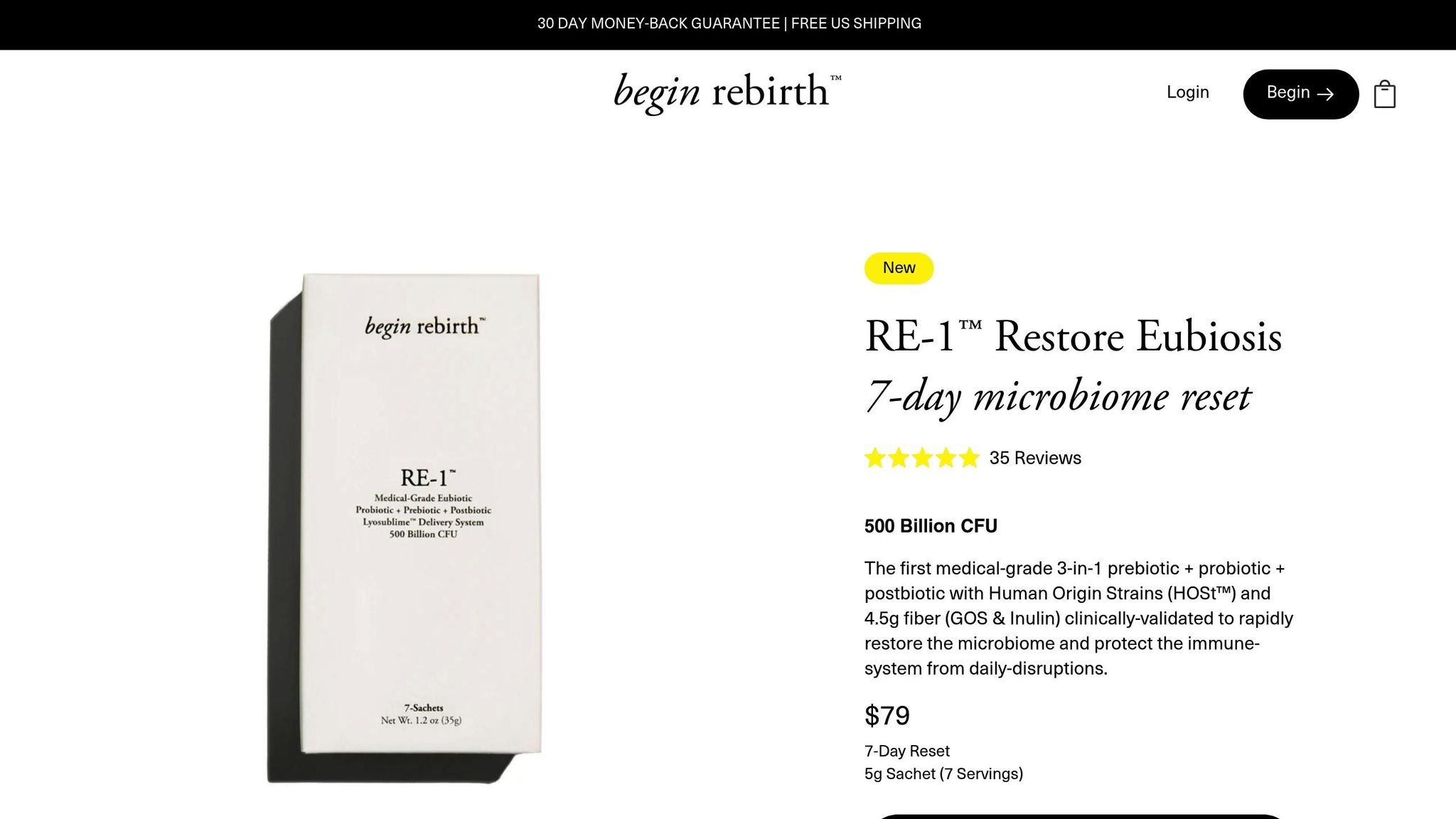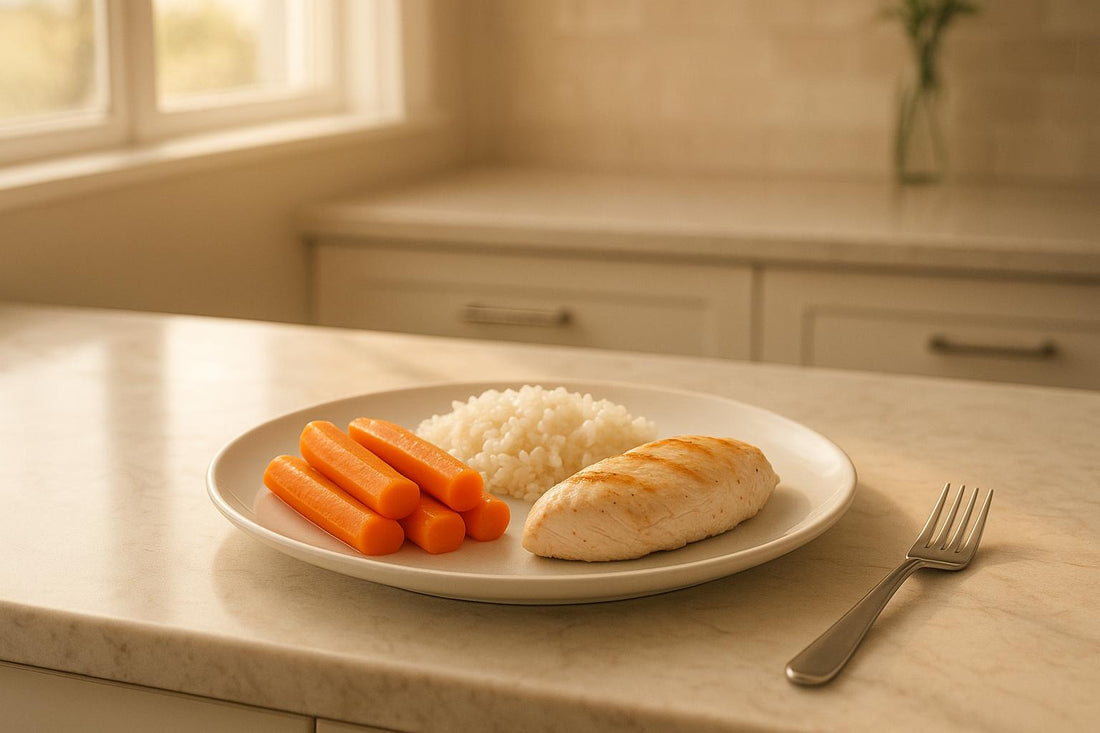Living with Inflammatory Bowel Disease (IBD) can be challenging, but a low-residue diet may help reduce symptoms like diarrhea, bloating, and abdominal discomfort. This diet limits high-fiber foods to ease digestion and support gut health. Here's a quick overview:
- What It Does: Reduces undigested material in your intestines, easing gut stress and improving nutrient absorption.
- Who It Helps: Those with IBD experiencing frequent diarrhea, cramping, and bloating.
- Key Foods to Eat: White bread, refined pasta, tender lean meats, well-cooked vegetables, and ripe bananas.
- Foods to Avoid: Whole grains, raw vegetables, tough meats, and high-fiber fruits like berries.
- Supplements: Probiotics and synbiotics can support gut health during this diet.
Effects of Low-Residue Diets on IBD
Reducing Gut Stress
A low-residue diet helps by limiting the amount of undigested material moving through your intestines. This reduction can ease gut stress and support tissue recovery. Here's how it works:
- Less mechanical strain on intestinal walls
- Decreased bacterial fermentation
- Fewer inflammatory compounds produced
- Better nutrient absorption
Adding the right supplements can amplify these benefits. For example, probiotics made with Human Origin Strains may help manage inflammation. Research shows Lactobacillus paracasei BR-MCC1849 can trigger cytokines that regulate inflammation and boost immune function. These dietary adjustments also bring noticeable changes to bowel habits.
Changes in Bowel Movements
Low-residue diets don’t just address inflammation - they can also improve bowel patterns. Here's a breakdown of the effects:
| Aspect | Change | Benefit |
|---|---|---|
| Frequency | Fewer daily movements | Less strain on the digestive system |
| Consistency | More formed, easier to pass | Reduced discomfort and cramping |
| Urgency | Fewer urgent situations | Easier to plan daily activities |
| Volume | Lower waste volume | Reduced intestinal pressure |
These improvements can make a big difference in day-to-day life. In fact, clinical studies report that 94% of participants experienced less bloating and abdominal pain when combining these dietary changes with targeted gut health supplements. Including adequate prebiotic fiber is also key - it supports beneficial gut bacteria and helps manage inflammation.
Food Guide for Low-Residue Diets
Recommended Foods
Here’s a list of foods that are gentle on your digestive system while still providing essential nutrients:
| Food Category | Recommended Options | Preparation Tips |
|---|---|---|
| Grains | White bread, white rice, refined pasta | Remove visible seeds or grains |
| Proteins | Tender lean meats, fish, eggs, smooth nut butters | Cook thoroughly; remove skin and excess fat |
| Dairy | Low-fat yogurt, cottage cheese, milk | Opt for lactose-free if needed |
| Vegetables | Well-cooked carrots, squash, peeled potatoes | Steam or boil until very soft |
| Fruits | Ripe bananas, canned peaches, applesauce | Remove all peels and seeds |
| Beverages | Water, clear juices, broth | Avoid pulp or sediment |
Cooking these foods thoroughly makes them easier to digest. Supporting gut health with supplements may also help maintain proper intestinal balance.
While these foods are safe for a low-residue diet, there are certain items you should avoid to prevent irritation.
Foods to Skip
Avoiding the following foods can help reduce digestive discomfort:
| Food Category | Foods to Avoid | Reason |
|---|---|---|
| Whole Grains | Brown rice, whole wheat, quinoa | High in fiber |
| Vegetables | Raw vegetables, corn, broccoli | Hard to digest |
| Fruits | Berries, dried fruits, citrus | High in fiber and acidity |
| Proteins | Tough meats, beans, lentils | Contain complex proteins and fiber |
| Dairy | Hard cheeses, ice cream | High fat content |
| Others | Nuts, seeds, popcorn | Leave undigested residue |
These restrictions are temporary. As your symptoms improve, many of these foods can be gradually reintroduced to ensure a well-rounded diet.
Starting a Low-Residue Diet
Meal Planning Steps
Plan your meals by combining one protein, one grain, and one cooked vegetable from the approved options. Keep portion sizes moderate for easier digestion.
| Meal | Components | Example |
|---|---|---|
| Breakfast | Protein + Refined Grain | Scrambled eggs with white toast |
| Lunch | Protein + Grain + Soft Vegetable | Baked chicken breast, white rice, steamed carrots |
| Dinner | Protein + Grain + Cooked Vegetable | Poached fish, pasta, cooked squash |
| Snacks | Approved Snack | Ripe banana or smooth peanut butter |
Use these examples to create a daily meal plan that's both simple and suitable for your diet.
Food Label Guide
When shopping, check the "Dietary Fiber" section on Nutrition Facts labels. Pick items with less than 2 grams of fiber per serving. Also, avoid products containing these fiber-rich ingredients:
- Whole grain flour
- Bran
- Seeds or nuts
- Dried fruits
- Added fiber or fiber supplements
Careful label reading helps ensure you're sticking to the low-residue diet while meeting your nutritional needs.
Meeting Nutritional Needs
To maintain balanced nutrition, focus on allowed foods that provide essential nutrients:
- Protein: Tender lean meats, fish, eggs
- Calcium: Low-fat dairy products, fortified beverages
- Iron: Lean meats, enriched white bread
- Vitamins: Canned fruits without seeds, cooked vegetables
Supporting your digestive health is key during this dietary transition. Discuss any supplements with your healthcare provider to ensure they align with your low-residue diet requirements.
These practical steps can help you manage IBD symptoms effectively while following a low-residue diet.
Returning to Normal Diet
Reintroducing Fiber
When transitioning back to your regular diet, ease fiber back in gradually to avoid any discomfort. Start with small amounts and monitor how your body reacts. Keeping a food diary can help you track any issues and make adjustments as needed.
Supporting Your Gut Health
Once you've reintroduced fiber, focus on maintaining a healthy gut. Here are some tips to support your gut during this phase:
- Stay Hydrated: Drinking enough water helps your body manage the added fiber effectively.
- Consider Supplements: Products like Begin Rebirth RE-1™, which combines fiber, probiotics, and a postbiotic, can offer additional support.
sbb-itb-1bbfe7f
Synbiotics and Low-Residue Diets
Managing Gut Bacteria
Low-residue diets can disrupt gut bacteria due to their limited fiber content. Synbiotics, which combine probiotics and prebiotics, help reintroduce helpful bacteria, support the existing microbiome, strengthen the gut barrier, and ease inflammation or discomfort. Synbiotic supplements can play a key role in rebalancing the gut when it's been compromised.
Begin Rebirth RE-1™ Features

Begin Rebirth RE-1™ is a specially formulated supplement that blends live probiotics, prebiotic fibers, and a postbiotic to help restore gut health. Each sachet contains 500 billion CFU of probiotics and 4.5 grams of prebiotic fiber (a mix of GOS and Inulin). The Lyosublime™ delivery system ensures the nutrients are absorbed efficiently along the digestive tract.
Clinical studies have shown the following benefits after just 7 days of use:
| Timeframe | Benefits | Percentage of Users |
|---|---|---|
| After 7 days | Reduced bloating and abdominal pain | 94% |
| After 7 days | Fewer allergies and infections | 87% |
The product also features Human Origin Strains (HOSt™), which are designed to restore the natural balance of gut flora. This is especially helpful for those on low-residue diets, where sources of beneficial bacteria are limited. For optimal results, take one sachet with water each morning on an empty stomach.
Dietitian's Tips on Following a Low Fiber Diet - Mayo Clinic

Summary
This section highlights how low-residue diets play a key role in managing IBD by reducing undigested material and easing digestive stress. Over the last century, modern lifestyles have led to a 50% decline in gut microbiome diversity.
Adding microbiome-focused supplements can make a big difference. For instance, 94% of users reported less bloating and abdominal pain, while 87% noticed fewer allergies within just seven days of using Begin Rebirth RE-1™.
Here’s a quick look at effective IBD management strategies:
| Aspect | Strategy | Expected Outcome |
|---|---|---|
| Diet Management | Stick to low-residue guidelines | Quick symptom relief |
| Microbiome Support | Use daily eubiotic supplements | Improved long-term gut health |
Begin Rebirth RE-1™ offers a unique blend: 4.5g of prebiotics, 500 billion CFU of probiotics, and postbiotics powered by HOSt™ technology. This combination provides fast symptom relief and promotes lasting gut health.
"RE-1 keeps me energized all day. The boost in clarity and stamina is real. It's my must-have travel essential - powerful protection against harmful bacteria and viruses. I feel much safer having it with me. Definitely worth the investment." - S R., Verified Buyer
FAQs
How soon can you expect relief from IBD symptoms after starting a low-residue diet?
The timeframe for experiencing relief from IBD symptoms after starting a low-residue diet can vary from person to person. While some individuals may notice improvements within a few days, others might take longer depending on the severity of their condition and how well they adhere to the diet.
It's important to consult with a healthcare provider or dietitian to ensure the diet is tailored to your specific needs and to monitor your progress effectively. A low-residue diet is designed to reduce strain on the digestive system, which can help alleviate symptoms like abdominal pain and diarrhea over time.
What are the potential risks or side effects of following a low-residue diet long-term?
While a low-residue diet can help manage symptoms of inflammatory bowel disease (IBD) during flare-ups, long-term adherence may pose some risks. This type of diet limits fiber intake, which is essential for maintaining a healthy gut microbiome and supporting regular digestion. Over time, this could lead to issues like constipation, nutrient deficiencies, or changes in gut health.
If you're considering a low-residue diet for an extended period, consult with a healthcare professional or a registered dietitian. They can help you balance your nutritional needs and recommend ways to support your gut health, such as incorporating supplements or gradually reintroducing fiber-rich foods when appropriate.
How can I safely add high-fiber foods back into my diet after following a low-residue diet?
Reintroducing high-fiber foods after a low-residue diet should be done gradually to avoid overwhelming your digestive system. Start by adding small portions of easily digestible high-fiber foods, such as cooked vegetables, peeled fruits, or oatmeal. Monitor your body’s response to these changes and adjust accordingly.
It’s also helpful to stay hydrated and chew your food thoroughly to aid digestion. If you’re unsure about which foods to reintroduce or experience any discomfort, consult your healthcare provider or dietitian for personalized guidance.

